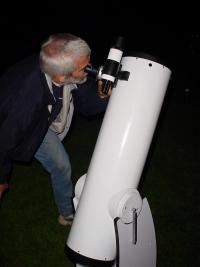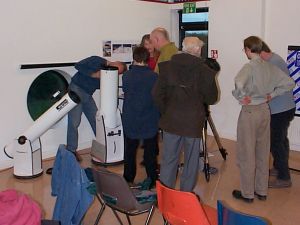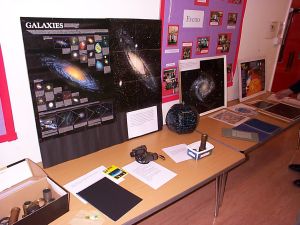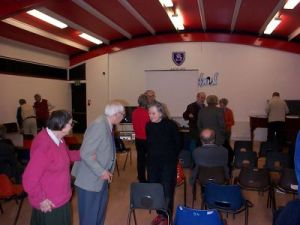News Archive
27 / 08 / 2003
Largely thanks to generous media coverage of Mars' unusually close approach to Earth this year, our Mars Week observing sessions have drawn good crowds - especially tonight, with 70 or 80 (mostly local) attendees. It was a fantastic sight! Here are a few snaps of some keen amateurs!


14 / 05 / 2002
This year's Tiverton Spring Festival was a great success for us, with 20 to 30 people attending the evening we planned. Neil started off by introducing everyone to the relative attributes of the society's new telescopes, and was followed by Angela and Douglas, who talked about the current, prosperous state of the society.


After a tea-break, everyone sat down most attentively to hear my lecture on the exploration of the Solar System by spacecraft. Douglas then gave a closing slide show on what there is to be seen in the night sky, after which we fittingly managed to bag some time on the telescopes!
03 / 05 / 2002
Dr. Percy Seymour, head of the Astronomy department at Plymouth University, gave us a fascinating lecture on the historic and scientific basis of astrology. This is a subject on which he has published several books, and involved students for doctorate work.

15 / 04 / 2002
Today we received the last part of our telescope order from SCS Astro, the 4.5" Meade DS-2114 ATS.
20 / 03 / 2002
Today we received the Orion UltraView 10x50 binoculars from SCS Astro.
21 / 12 / 2001
Today we received the first part of our telescope order from SCS Astro, which includes the 8" Meade LX-90, the 8" Helios Skyliner 200 Dobsonian, and the 4" TAL 100-R refractor.
31 / 10 / 2001
Douglas attended the New Opportunities Fund's lunch and presentation ceremony in Exeter, and was lucky enough to be presented with a plaque!

26 / 10 / 2001
We received our grant money from the New Opportunities Fund branch of the Lottery Commission today. We will now purchase the instruments that our committee has chosen.
12 / 08 / 2001
The Starbecue was a great success last night (despite the unbroken cloud cover), thanks largely to Mike's super organisation for the event. It became a great way to begin our new astronomical season, which resumes on Friday 7th September at St. Aubyn's. It was good to see a few new faces as well, and we hope they will continue to come along, undeterred by the weather!
01 / 06 / 2001
David Tucker treated us last night to a valuable insight into the formation of the British Astronomical Association (BAA), of which he is the current treasurer. It took only a couple of months in late 1890 for it become an official body following an initial suggestion by letter!
David also gave us the welcome news that the Royal Astronomical Society (RAS) has undertaken the task of archiving the documents of the BAA for future generations.
05 / 05 / 2001
Dr Allan Chapman provided us with a first-rate discussion of Victorian amateur astronomy last night. He displayed an intimate knowledge of this occasion's topic, and delivered it in an extremely fluid, undemanding style - never once referring to a note or losing his stream of thought.
Like the many guests present, I was absolutley gripped from the start. Glancing at my watch at the end of his lecture, I was astonished to note that well over an hour and a half had passed! He spent the entire first 15 minutes providing us with an overview of the social, economic and political scenes and attitudes in Britain and Europe. This later proved to be absolutely essential in understanding the subject and direction of his lecture.
Through the course of his lecture, he introduced us to many key figures of the Victorian astronomical scene. These included internationally well-known figures, right down to local amateurs - some of whom were absolutely remarkable self-taught individuals.
08 / 04 / 2001
We had a grand day out visiting Goonhilly Earth Station, located in a nature reserve on the Lizard peninsula in Cornwall. The tour of the complex included a couple of audio-visuals, and offered good views of the parabolic radio antennae (from an old operations tower and the tour bus), which are used for communication with the rest of the world. British users go through Goonhilly if visiting a foreign website or making an international phonecall. The signal's journey will take this route: -
signal origination > local exchange > Goonhilly earth station > satellite > foreign earth station > local exchange > signal destination
The dishes are all named after characters from Arthurian legend, including Arthur (the original dish, opened in 1962), Merlin (the largest dish on the site, allowing communication with the States), Guinevere (which allows communication with the East) and Lancelot.
02 / 03 / 2001
Our thanks go to Mr Arthur Davis for his excellent discussion of the Milky Way and his guide around the heavens. We all came away with something to look out for next time we're out with the telescope! Thanks also to Mike, one of our committee members, who did a splendid job hosting the evening in Douglas' absence.
23 / 01 / 2001
We are planning a new club called Tiverton Young Astronomers for children aged 9 - 12. If things go according to plan, it will begin in August 2001. It will be run by members of Tiverton AS, and meetings will be held at St Aubyn's School. For more information, see our TYA meetings page.
10 / 10 / 2000
Mr Stephen Manaton is selling his Meade ETX-90EC (a Maksutov-Cassegrain reflector with a 96mm / 3.8" primary mirror), Autostar Computer Controller and Field Tripod. He includes 26mm and 9.7mm eyepieces, a right-angled viewfinder, several books and Sky Map Pro (a computer program). This all orginally cost around £1000, but he is selling it for around £550, and would teach the purchaser how to use the telescope equipment. If you're interested, call him on 01884 257405, or you can e-mail him.
01 / 10 / 2000
There must have been a record attendance at the talk by Mr Ian Walsh of Torbay A.S. on 8th Sept. We started off by discussing what we had seen in the last few months [of the summer recess].
He then brought in his models of the Solar System and showed some slides of the universe so we could get the feel of it. Next, he showed us his model of the Solar System and explained the scale of it all. His models were very detailed. I thought that the talk was very in-depth and it illustrated the vast scale of the Solar System.
Entry written by Sam, one of our younger members
09 / 06 / 2000
Some of our members arrived early to have a group photograph taken just before Dr David Brabban's excellent discussion of mass.
The lecture illustrated the importance of mass in determining the strength of gravitational fields generated by objects as small as apples to large clusters of galaxies. He effectively described how Sir Isaac Newton's theories of gravity enhanced our understanding of Johannes Kepler's purely observational theories of planetary motion. (For more on planetary motion, see the Planetary Physics page in the 'Solar System' section.)
We also discussed our choices of telescope equipment again, and decided almost unanimously to request funds for 3 instruments; a large reflector (possibly a Dobsonian), a medium-sized reflector, and a small refractor. This selection of instruments would benefit the whole group, as our members have varying levels of observing experience.
The end-of-season get-together was held at the Merriemeade Hotel in Sampford Peverell. A pleasent evening was spent after the last meeting of the season, during which members reflected upon the year's astronomical events over a glass or two!
Observing sessions begin again on 6th September 2000 on every clear Wednesday night from 9:30 pm.
11 / 05 / 2000
The first committee meeting took place this evening. A number of important points were discussed, including the various options available over choice of telescope should we be eligable for a Millennium grant. The most popular choice (and most cost-effective) would be a Dobsonian with a 16" primary mirror.
Don't forget that the telescope will be open to the public on three evenings from 9:30pm (weather-permitting) during the Tiverton Spring Festival:-
Monday 15th May 2000
Wednesday 17th May 2000
Friday 19th May 2000
UPDATE: The Mid Devon Gazette briefly reported on these public viewings of the night sky, in the Tuesday 6th June 2000 edition. They also mentioned the web site.
15 / 01 / 2000
This year's meeting schedule is now online. The first meeting will take place on Friday 4th February.
16 / 10 / 1999
We had an excellent talk yesterday from Mr John Meacham of Bristol Astronomy Society, who gave a talk on observing techniques. He showed us some slides illustrating his own observations, and mentioned his interest in lunar phenomena and variable stars.
The demonstration of the web site went very well, and I was very happy that so many people took an interest in it. In case you've come back for another look, please use it regularly as I will keep it up-to-date with the latest events we have planned.
Douglas also mentioned that we will be travelling down to the observatory and planetarium in Sidmouth on Friday 19th November. We will meet briefly at 7:30pm at Blundell's.
18 / 09 / 1999
The 'members evening' meeting went well yesterday (except for the demonstration of the web site!). We heard talks on the history of manned and unmanned exploration of the Solar System, seasonal variations in Arctic sea ice concentrations, and on a Meade LX10 (cassegrain) telescope.
Later on we went up to the telescope and observed the Moon (briefly, as it was clouded over in a matter of minutes) and Jupiter with the Meade. We could see four dark bands with the highest magnification; the two prominent equatorial bands and also the fainter northern and southern temperate belts. (For more on Jupiter's cloud features, visit the Jupiter page in the 'Solar System' section.)
09 / 09 / 1999
The Solar System section of the web site was uploaded at around 2:45 am. Constructive criticism and suggestions for new topics are welcome.
26 / 06 / 1999
Last night's attenders enjoyed Douglas's talk on 'Moonfolk', which turned out to be a discussion of the Moon's influence upon literature. Folklore and other myths associated with the Moon were involved, including the origins of the Easter Bunny!
We went up to the telescope at 9:30 pm and observed the Moon, Venus and finally Mars until just after 11:00 pm. The Moon was nearly full, making it very bright to observe, but some high altitude cloud helped to screen out most of the glare. Venus was an extremely well-defined crescent although none of its cloud detail could be observed, and Mars was also featureless because of the cloud and its current distance from the Earth.
16 / 05 / 1999
The telescope will be open for the next 3 Wednesdays from 10:00pm - that's on the 19th and 26th of May and on the 2nd June. Observing sessions will resume on Wednesday 1st September at 9:00pm.
14 / 05 / 1999
Around 45 people used the telescope on the third night of Tiverton Spring Festival, after the first two nights (the 10th and 12th) were clouded over. They observed Mars, Venus and the wonderful double star Gamma Leonis (g Leonis), which lies at a distance of around 170 light years, before it clouded over again.
There was a record attendance at the meeting today, with approximately 55 people turning up to hear Mr. David Tucker talk about the eclipse.
02 / 1999
The 8" primary mirror of the Society's telescope was resilvered by Orion Optics.